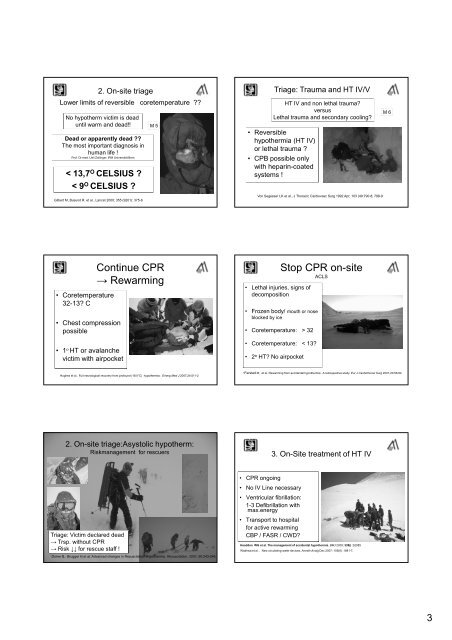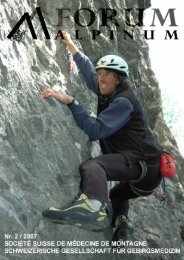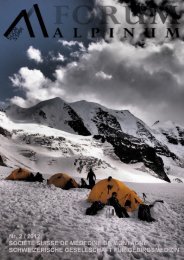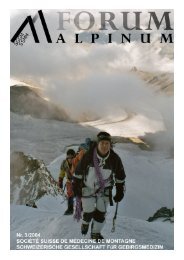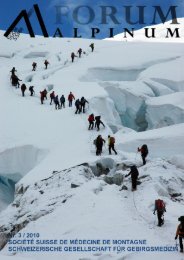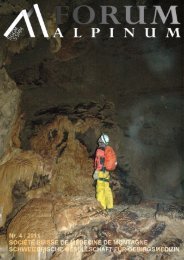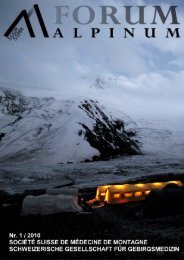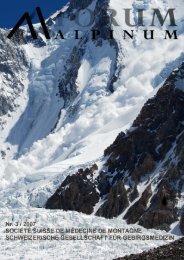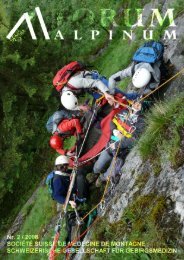abstracts 2010 - Schweizerische Gesellschaft für Gebirgsmedizin
abstracts 2010 - Schweizerische Gesellschaft für Gebirgsmedizin
abstracts 2010 - Schweizerische Gesellschaft für Gebirgsmedizin
Sie wollen auch ein ePaper? Erhöhen Sie die Reichweite Ihrer Titel.
YUMPU macht aus Druck-PDFs automatisch weboptimierte ePaper, die Google liebt.
2. On-site triage<br />
Lower limits of reversible coretemperature ??<br />
No hypotherm victim is dead<br />
until warm and dead!!<br />
Dead or apparently dead ??<br />
The most important diagnosis in<br />
human life !<br />
Prof. Dr.med. Ueli Zollinger, IRM Universität Bern<br />
< 13,7 O CELSIUS ?<br />
< 9 O CELSIUS ?<br />
Gilbert M, Busund R. et al., Lancet 2000; 355 (9201): 375-6<br />
• Coretemperature<br />
32-13? C<br />
• Chest compression<br />
possible<br />
• 1 o HT or avalanche<br />
victim with airpocket<br />
M 5<br />
Continue CPR<br />
→ Rewarming<br />
Hughes et al.. Full neurological recovery from profound (18.0°C) hypothermia: Emerg Med J 2007;24:511-2<br />
2. On-site triage:Asystolic hypotherm:<br />
Riskmanagement for rescuers<br />
Triage: Victim declared dead<br />
→ Trsp. without CPR<br />
→ Risk ↓↓ for rescue staff !<br />
Durrer B., Brugger H.et al. Advanced changes in Resuscitation Hypothermia. Resuscitation. 2001; 50:243-246<br />
Triage: Trauma and HT IV/V<br />
HT IV and non lethal trauma?<br />
versus<br />
Lethal trauma and secondary cooling?<br />
• Reversible<br />
hypothermia (HT IV)<br />
or lethal trauma ?<br />
• CPB possible only<br />
with heparin-coated<br />
systems !<br />
Von Segesser LK et al., J Thoracic Cardiovasc Surg 1992 Apr; 103 (49:790-8; 798-9<br />
• Lethal injuries, signs of<br />
decomposition<br />
Stop CPR on-site<br />
ACLS<br />
• Frozen body/ mouth or nose<br />
blocked byy ice<br />
• Coretemperature: > 32<br />
• Coretemperature: < 13?<br />
• 2 o HT? No airpocket<br />
M 6<br />
•Farstad M, et al. Rewarming from accidental hypothermia . A retrospective study. Eur J Cardiothorac Surg 2001;20:58-64<br />
• CPR ongoing<br />
• No IV Line necessary<br />
• Ventricular fibrillation:<br />
1-3 Defibrillation with<br />
max.energy<br />
• Transport to hospital<br />
for active rewarming<br />
CBP / FASR / CWD?<br />
3. On-Site treatment of HT IV<br />
Headdon WG et al. The management of accidental hypothermia. BMJ 2009; 338() :b2085<br />
Wadhwa et al. , New circulating-water devices, Anesth Analg Dec 2007; 105(6) :1681-7,<br />
3


